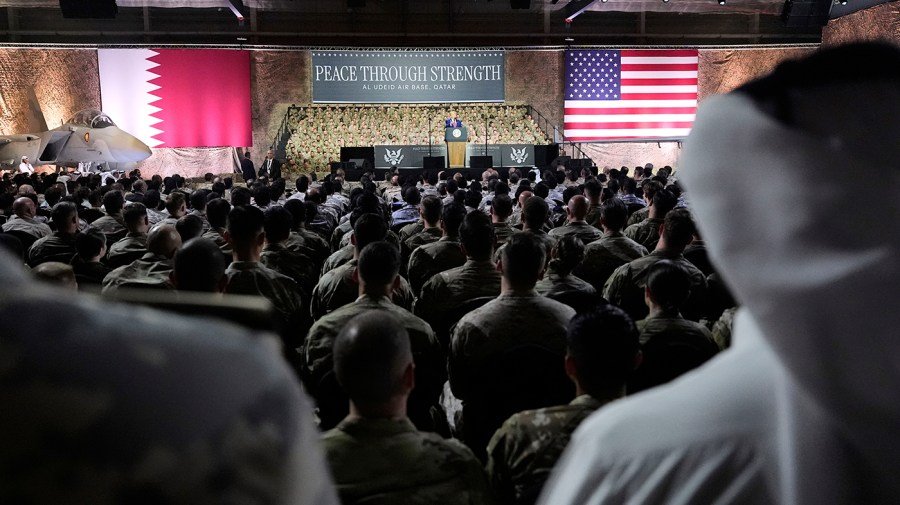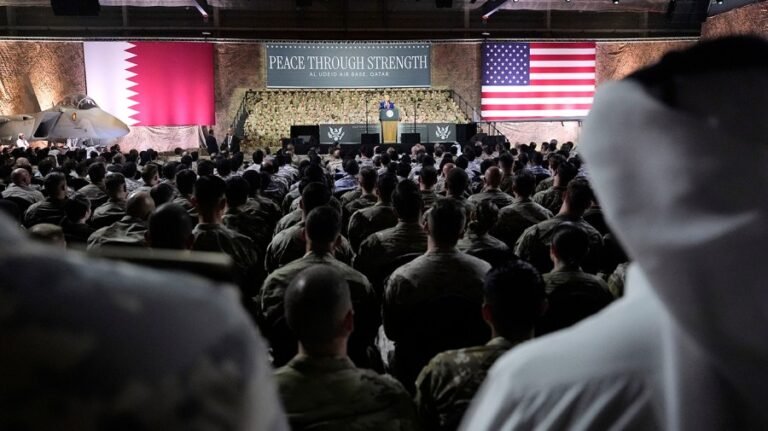
Tens of thousands of U.S. troops are within Iran’s striking distance should President Trump decide to wade into Israel’s conflict with Tehran and directly attack the country.
More than 40,000 American service members and civilians – as well as billions of dollars in military equipment – are in the Middle East, spread out across bases in Syria, Iraq, Jordan, Kuwait, Bahrain, Qatar and the United Arab Emirates.
Those working in countries closest to Iran, including Iraq and Kuwait, would conceivably have only minutes to prepare for an incoming Iranian strike, a likely outcome should Trump order the U.S. military to join Israel’s bombing campaign, experts say.
“If [Iran] had the ballistic missiles ready to go, those strikes could happen in under 15 minutes. Launched to target,” retired Col. Seth Krummrich, vice president at security consultancy firm Global Guardian, told The Hill. “They move very quickly.”
Israel last week unleashed a barrage of airstrikes on Iran that set off the largest conflict ever between the two regional adversaries, with Tehran responding with its own attacks. The war has threatened to pull in the U.S., which says it supports Israel’s right to defend itself but has not directly involved itself in the bombing.
Trump has not yet decided on possible American military action against Iran, telling reporters through his top spokesperson that he would make his decision within a fortnight.
“Based on the fact that there’s a substantial chance of negotiation that may or may not take place with Iran in the near future, I will make my decision whether or not to go in the next two weeks,” according to the Trump statement relayed by White House press secretary Karoline Leavitt on Thursday.
But Iran has already threatened to directly attack U.S. forces should they enter Israel’s war campaign, with the country’s supreme leader, Ayatollah Ali Khamenei, warning on Wednesday that “Americans should know that any U.S. military intervention will undoubtedly be accompanied by irreparable damage.”
Tehran’s threats aren’t idle, as the country has retaliated against Washington in the past, most notably in January 2020, when Trump in his first term ordered an airstrike that killed Maj. Gen. Qassem Soleimani, the head of Iran’s elite Quds Force.
The strike, which happened as Soleimani traveled to Baghdad, prompted a swift response from Iran, which days later hammered Al Asad Air Base in Iraq and another U.S. base in Erbil with 13 ballistic missiles. While no Americans were killed in the largest ballistic missile attack ever against U.S. forces abroad, more than 100 were later diagnosed and treated for traumatic brain injuries.
Now, with Trump reportedly considering using the GBU-57 – known as the Massive Ordnance Penetrator or so-called “bunker buster” bomb – to damage Iran’s Fordo nuclear enrichment facility, a similar attack from Tehran could soon be at hand.
“If there was to be a U.S. attack like they dropped the big bunker buster, if that happened, then I would assume that you would see an Iranian missile strike aimed at one or multiple U.S. bases,” said Krummrich, a former Special Forces officer in Iraq and Afghanistan.
In the face of such a threat, military officials move to pull valuable assets out of the bases deemed most likely to be attacked, he said, pointing to the departure of some aircraft from Al Asad Air Base, as seen in public satellite imagery this week.
He guessed that Al Asad Air Base, where many of the roughly 2,500 U.S. troops stationed in Iraq are located, as the most likely target given its close proximity to Iran and the fact that it’s been hit in the past.
Iran “would tend to not want to poke the eye” of the United Arab Emirates, where 3,500 U.S. military personnel are located, or Qatar, home of Al Udeid Air Base, the largest U.S. military site in the Middle East, Krummrich predicted. About 10,000 American forces are at Al Udeid, the regional headquarters for the U.S. Central Command.
In addition, 13,500 U.S. troops are stationed across five bases in Kuwait, 9,000 military and civilian personnel are at the Navy’s Fifth Fleet headquarters in Manama, Bahrain, and hundreds more troops placed elsewhere on bases run by Jordan, Syria and Oman.
The former head of Centcom, retired Army Gen. Joseph Votel told The Hill that Middle East bases have protective measures built into them to reduce risk, pointing to the aircraft moved from more vulnerable installations,
“But of course, we have a lot of diplomatic facilities, we have a lot of private sector interests there that could be vulnerable as well,” said Votel, now at the Middle East Institute. So, There’s a lot of opportunity for Iran here.”
U.S. bases and those that house American troops are also at risk of being attacked by Iran-back militias in the region, like in the case when three Army soldiers were killed in a drone attack on a small U.S. outpost in Jordan in January 2024.
Following Israel’s strikes on Iran on June 13, three drones were shot down near Ain al-Asad air base in western Iraq, The Associated Press reported.
At least four other U.S. bases in Iraq and Syria have come under fire from Tehran-supported militants since Israel’s bombing campaign began, including three installations in northeastern Syria between June 14 and 15, according to local reports.
Asked about the attacks, a spokesperson from U.S. Central Command would not confirm or deny whether they took place.
“We are aware of these reports but have nothing operational to provide,” they said, pointing further queries regarding the conflict between Israel and Iran to the White House.
U.S. officials this week have insisted that U.S. forces are well prepared to respond to any Iranian-launched attacks, surging more firepower to the Middle East including the USS Nimitz aircraft carrier strike group. The Pentagon also has moved refueling tanker aircraft to the nearby European theater, and placed warships in the Mediterranean Sea to help shoot down Iranian missiles targeting Israel.
The Nimitz is set to take over from the USS Carl Vinson aircraft carrier, currently in the Arabian Sea to provide security for U.S. forces near the Gulf of Oman and the Persian Gulf, but the two vessels will likely overlap for several days.
More covertly, the Air Force earlier this week moved a dozen F-16 fighter jets from a base in Italy to Prince Sultan, Saudi Arabia, according to Aurora Intel, which reviews open source information in the Middle East.
Defense Secretary Pete Hegseth on Wednesday declined to say whether he had been asked to provide Trump with military options for Tehran, saying during a Senate Armed Services Committee hearing that he “wouldn’t disclose that in this forum.”
But he added that his job is “to make sure the president has options, is informed of what those options might be, and what the ramifications of those options might be.”
Hegseth also on Wednesday told senators that “maximum protection” measures were in place in the region.
Asked by The Hill whether the protections could adequately repel an Iranian attack, a Pentagon spokesperson referred the outlet to Hegseth’s post to X on June 16, when the Defense secretary announced the “deployment of additional capabilities” to the Middle East.
“Protecting U.S. forces is our top priority and these deployments are intended to enhance our defensive posture in the region,” he said.


